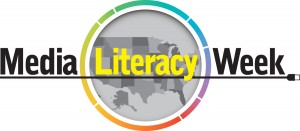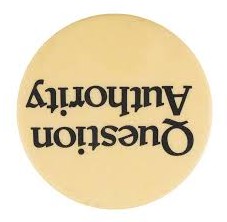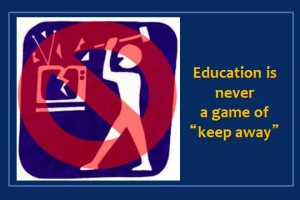It’s tempting to fantasize. Who would be the President-elect if every viewer, listener, and reader had questioned media messages more deeply? Maybe there would have been a different winner. Then again, maybe not.
Human behavior is complex and often based on non-cognitive factors. No amount of education – even if it is excellent education – can change that. So I don’t know whether universal media literacy education would have changed the outcome of an election in which economic uncertainty, religious doctrine, and cultural constructions of manhood were major factors in ways that had nothing to do with media. What I do know is that it will be impossible for people on opposing sides to trust or respect one another – or trust that election results are a valid reflection of what the nation wants – until everyone is media literate.
The logic goes something like this: If I don’t trust the media you rely on, and I suspect that you accept without analysis the narrative offered by those media, then I don’t trust you either. And we know that fewer than one in five Americans trust national news organizations.
In practice, Donald Trump’s campaign to discredit mainstream media as “dishonest” and “rigged” is one of the things about him that scares me the most because it allows him to dismiss all criticism. His constant “believe me” refrain dares the public to choose between our President-Elect and the Fourth Estate. Mr. Trump doesn’t just ridicule media mistakes (which, admittedly occur far too often); he labels every report that questions his actions, popularity, veracity or ethics a lie, facts-be-damned. If he can convince the country to ignore media while also retaining single party control of all branches of government, that leaves no check on his power.
But let me be clear. This isn’t just about not trusting media. It’s about not trusting each other. If news accounts claim to be about people like me, but I don’t recognize myself in anything they say, I mistrust both the news sources and anyone who believes them. If you use Facebook to traffic in information that is demonstrably false, it’s hard to imagine ever trusting your judgment on anything. If I don’t think you value evidence or we can’t agree on what counts as credible evidence, dialogue is impossible. As President Obama noted in a November 17 press conference:
“If we are not serious about facts and what’s true and what’s not, and particularly in an age of social media when so many people are getting their information in sound bites and off their phones, if we can’t discriminate between serious arguments and propaganda, then we have problems.”
The election made clear that large segments of the American population view the world in seriously divergent ways. If we can’t find common ground based on shared values, facts are all we have left. If we can’t find ways to engage in fact-based exchanges of ideas about pressing issues that affect us all, we edge perilously close to that thin margin where the fabric of society begins to unravel.
||=||=||=||

Check posts at Snopes.com before forwarding
The 2016 U.S. presidential contest fed media-motivated mistrust like cocaine feeds a crack addict. Fake news posts and tweets from widely discredited conspiracy theorists and white nationalists were shared (without critical comment) by thousands. Much of TV news was an epic fail and online sites were as likely to be dominated by partisan bloggers as by people adhering to professional standards of journalism (like fact checking or confirming that the sources they cite are real).
There were a few journalists who meticulously researched and documented their stories (David Farenthold’s work on the Trump Foundation comes to mind), but mostly news media contributed more to mistrust than to greater understanding. More than a few observers have noticed the problem and are calling for news media to do better. Like Bernie Sanders, many have questioned whether the handful of large media conglomerates that control most of our major news outlets can ever effectively fulfill the central (and essential) functions of journalism in our democracy to provide a check on power and to foster an informed citizenry.
I share concerns about a news ecosystem that structurally encourages superficial coverage and fake news, that allows celebrity to trump substance, that substitutes speculation for reporting, that relies on big data over local journalists on the ground, that normalizes misogyny, racism, and worse, and that measures success by ratings, clicks, or sales rather than by whether the public is well-informed. But no matter how much we succeed in efforts to reform media, as long as we treasure free speech, misleading information will always be a part of the mix.
That’s why the best hope for civil society to prevail against media-generated mistrust, anger, fear, and divisiveness is media literacy education. As NAMLE Executive Director, Michelle Ciulla Lipkin, suggested,
“The information avalanche is not coming to a stop any time soon. Media continue to be the loudest voices in our ears and in our children’s ears each and every day. As media literacy practitioners and advocates, we must get louder and fight harder for these essential skills to be taught in every classroom in every school in the U.S.”
She goes on to urge people to join NAMLE (it’s free) and get involved in the organization’s push for States to integrate media literacy into education requirements and teacher preparation programs. I concur.
||=||=||=||
Simply put, media literacy education is vital to our path forward as a nation. But it can’t just be any version of media literacy education. Media literacy educators need to own up to fact that we’ve contributed to the mistrust eating away at our nation. We’re part of the problem. For us to become part of the solution, we need to acknowledge and eliminate the aspects of our practice that foster a willingness to dismiss legitimate news sources as fake and accept fringe sources as genuine.
SEVEN MEDIA LITERACY MISSTEPS
1. We talk about THE media or use the term “media” (erroneously) as a singular.
We rarely actually mean “all media” when we use “THE media” as a singular, but we nonetheless imply that there is some sort of unified conspiracy. It logically follows that if all media are working in consort, then once we expose mistakes by one, it’s easy to dismiss them all.
Sometimes we sound very much like Mr. Trump when he accuses “the media” of being “rigged” (though we might be more likely to use the term “biased”). Of course, he is exempting sources that he favors, like Drudge or Breitbart or Infowars, just like media literacy educators tend to exempt, without explicitly saying so, their favorite sources. For years I’ve urged critics of children’s television to stop overgeneralizing. They’d always reassure me that they didn’t mean Mister Rogers’ Neighborhood or Reading Rainbow, but their audiences didn’t know that. When critics said “children’s TV,” parents heard “all children’s TV.”
There are legitimate reasons that we sometimes lump diverse media together. It makes sense when we want to explain that the effects of media messages tend to be powerful only when they are cumulative and from multiple sources, or when we want students to understand the structures of commercial news and how those structures influence who is in the news room, the stories they choose, and the way they tell those stories.
But, in fact, not all media speak with one voice nor are all media commercial. Those that are, are competitors, often owned and run by people who don’t share interests and don’t like each other. And in the wake of a couple of decades of media consolidation, the same giant corporation can own media outlets that do very different things and are operated in very different ways. When we blend them together by using phrases like “the media is…”, we not only make it easier for people to accept conspiracy theories, we also misrepresent reality.
An Alternative: Stop accepting student work or using media criticism that:
- issues blanket condemnations of all media
- describes media patterns or structures as “conspiracies”
- uses “media” as a singular noun and/or
- relies on over-generalizations.
Help students think of phrases that might describe a topic more precisely, e.g., “corporate media culture” or “24/7 cable news” or “syndicated talk radio,” etc.
2. We only engage students in critiquing media we don’t like.
When we limit deep-dive classroom discussions to books, we leave students with the impression that it isn’t important to think about any other forms of media. Likewise, when we engage students in analysis only of media that we believe misrepresent the world, the message students receive is that as long as the media I’m looking at present the world as I see it, there’s no reason to bother with questioning. Now imagine how they handle a fake news story that shows up in their Facebook feed. As long as they agree with the perspective, why would they bother to ask if it’s fake or not?
An Alternative: Help students develop analysis skills as a habit that they apply to all media all the time. Provide opportunities to analyze media from a wide range of perspectives, genres, and formats.
3. We expose students to media critics without teaching them to analyze media for themselves.
I’ve learned a lot from media critics over the years and I want media literacy educators to continue connecting students to brilliant works of media criticism, from Chomsky’s Manufacturing Consent to the social commentary featured in the impressive collection of films distributed by the Media Education Foundation. But just watching someone at their craft – no matter how great they are – doesn’t teach an observer how to do it.
I can watch Serena Williams win a hundred championships, but that won’t make me great a tennis player. If I’m already experienced and know what to look for, I may notice a technique or strategy that would improve my game, but even then, I’d still have to actually play if I wanted to master the necessary skills.
The same is true for media criticism. When we assign students to watch, read, or listen to media critics we may be hoping they’ll pick up critical inquiry and observation skills. But unless we pause to point out the critic’s methods and invite students to analyze the arguments, they won’t, especially if they are novices. They might gain some new insight, or replace their own judgement with the critic’s, but they won’t become independent thinkers capable of doing their own media criticism. And that’s a problem because there are lots of propagandists who spin convincing tales. If what we’ve modelled is how to accept, rather than engage with compelling arguments, we leave students vulnerable to being manipulated, even if the arguments they are learning to accept are spectacular.
An Alternative: Provide students with frequent opportunities to practice doing the work that it takes to analyze and critique media for themselves. And require them to apply media literacy analysis skills to the media critics you introduce.
4. We ask “Who made this and why?” and then stop.
We nearly always ask authorship and purpose questions of media messages because knowing origin and intention is key to analyzing meaning and veracity. The problem comes when we assume that maker and motive are the sum total of what one needs to know in order to make a determination about meaning or veracity.
So, for example, there are media literacy educators who teach students that advertising claims are never credible because they are created by people whose only goal is selling and those folks aren’t concerned with what’s actually in your best interest. Even when that’s true, it’s an interpretive shortcut we can’t afford because it means that students never actually develop the skills to investigate the claims.
We saw this exact skill gap play out over and over during the election, with Clinton supporters dismissing everything that came from the Trump campaign and vice versa, just because the source was their opponent, while accepting without question everything that came from their own political party. As a result, both sides missed information that would have helped them better understand what voters wanted and needed, and many voters accepted as accurate information from their own side that wasn’t.
An Alternative: Keep the focus on examining the evidence for claims before jumping to conclusions one way or another, no matter who crafted the message or their purpose. It would also help to
- teach students to ask the same analytical questions of all media,
- use the plural for questions about authorship and purpose so students understand that there are often multiple contributors and motives for any given message, and
- follow up authorship or purpose questions with, “Why might it matter [to know this]?”
5. We imply that to be media literate one needs to pass an ideological litmus test.
As educators, it’s our responsibility to reject ideologies of hate that harm students and destroy society. With that exception, we have to be respectful of the widest possible range of views. We can’t model open inquiry and also demand that everyone become a ________ (fill in the blank: socialist, Christian, Libertarian, etc.).
This is really a question about requiring media literacy education for every student in every school just as we require traditional reading, writing, and arithmetic. If we are serious about reaching everyone, we need to acknowledge that our nation is diverse and deeply divided and be prepared to meet students where they’re at and with respect.
If we really want universal media literacy education, and we don’t want students (or their parents and teachers) to shut us out before we’ve started, we can’t urge students to reject capitalism even if we, personally, believe that capitalists use media to distort the culture to serve corporate ends. We can’t require students to be reborn as Christians because media value messages about sex or gender contradict our religious convictions. It’s natural to take inspiration from wherever we find it, but we can’t force everyone else to find inspiration in the same place. Indoctrination is not the same thing as education.
An Alternative: Rather than encouraging (either directly or implicitly) adherence to a religious or political ideology, focus on skills and dispositions. Teach students to identify the sources of their ideas, provide evidence and logical argument to back up their interpretations, and respect differing interpretations as long as they are reasonable and evidence-based. Require students to become effective, creative, reflective, and responsible communicators, even if what they end up saying challenges our own views. Encourage students to act on what they’ve learned, but don’t tell them what to do.
6. We frame the task as “Don’t be fooled.”
Ever wonder why traditional literacy is never framed as “We need to teach students to read and write so they won’t be fooled?” Yet, it’s common to hear media literacy educators justify their work with exactly that argument. We even say things to kids like, “Don’t be fooled by that toy ad – the actual toy is not that big.” Or, “Don’t be fooled by that cigarette or alcohol ad that makes it look like people who smoke or drink are healthy, active, and beautiful.” Imagine the likely student reactions to this framing:
- You’re right. I’ve been fooled. So I must be a fool.
- If my job is to make sure I’m not fooled by media, and it’s clear to me that I’m not very good at that yet, I’ll reject everything just to make sure I’m safe and won’t make any embarrassing mistakes.
Obviously it’s not good educational practice to make students feel dumb. When we tell students that they’ve been duped, they are less likely to hear “Don’t just accept media messages – question them,” than, “Don’t believe media messages because only fools believe them.”
An Alternative: Media literacy is not about instilling blanket disbelief, it’s about teaching discernment. We help students develop discernment skills by teaching them how to uncover meaning for themselves, not by interpreting media messages for them. We make them feel empowered by giving them tools, not by showing them that they’ve been fools.
7. We present power as a zero sum game.
I believe that proponents of critical literacy have it right when they insist on teaching students to examine the world in a way that reveals power relationships. It’s especially important to call attention to the role that media (and media owners) play in setting both personal and national agendas. But we have to be careful that in the process we don’t imply that media have all the power and individuals have none.
Students who see themselves as powerless against insurmountable media influence are likely to:
- Become cynical rather than skeptical
Cynics stop asking questions – exactly the opposite of what we want. As the late journalist Gwen Ifill (z”l) observed, “cynics think they know the answers already, and then they stop listening. Skeptics always have more questions to ask, but we are willing to be persuaded to the honesty of an alternate point of view.” Media literacy education has to be about developing a nation of skeptics.
- Withdraw rather than engage in civic life.
After all, what’s the point of engagement if I have no power? In fact, if I have no real power, isn’t my best bet to hand over control to a benevolent authority (and isn’t that exactly what’s been happening with the global rise of nationalism and the election of leaders like Donald Trump)?
An Alternative: Show students that they have a place in the power structure by engaging them in discussions about what does and doesn’t serve the public interest. Encourage them to become advocates for changes they’d like to see. Make sure they know about existing media initiatives that promote social justice. Create media making opportunities and demonstrate a genuine appreciation for student voices by facilitating the public sharing of the media they make.
||=||=||=||
It is clear to me that media literacy proponents must demand better from journalists, social media sites, and our political leaders. We must also demand more from ourselves.
Despite our missteps, media literacy education holds great promise for helping the nation develop the kind of informed and engaged citizens so essential to democracy. As Michelle Lipkin reminds us, it is media literacy educators who believe that, regardless of political affiliation, “everyone needs to learn:
1) to distinguish between fact and fiction.
2) to be aware of the blurred line between entertainment and news.
3) to think critically about the avalanche of information we are receiving on a daily basis.”
If you’re looking for examples of media educators who avoid the missteps, check out the resources available from Project Look Sharp for studying presidential campaigns, war & peace, or environmental sustainability, or the Media Education Lab initiative on analyzing propaganda, or The Lamp’s approach to engaging students in video production.
Research confirms the potential of media literacy. A study released in November by Joseph Kahne and Benjamin Bowyer, Educating for Democracy in a Partisan Age: Confronting the Challenges of Motivated Reasoning and Misinformation “found that political knowledge did not improve judgments of accuracy but that media literacy education did.”
Because media literacy education is based, in part, on the premise that everyone interprets media through the lens of their own experience, media literacy educators welcome diverse voices and interpretations. The focus is on evidence and reason, not adherence to a predetermined party line. If media literacy education has an ideology, it’s a devotion to strong sense critical thinking, creative inquiry, and open-mindedness. When we avoid the missteps, media literacy classrooms are models for the type of dialogue that keeps democracy healthy.
In my vision of a media-literate nation there isn’t political uniformity. Disagreements over values and strategies mean that people will continue to vote for diverse range of parties and candidates. That’s what is supposed to happen in a democracy. But everyone will be able to trust that opponents are well-informed and understand what’s at stake. Disagreements won’t dissolve into demonizing. And when elections are over, we will find common ground and work together to make the nation a better place. We’re not there right now, but we can get there.
Every day I’m inspired by colleagues who are teaching media literacy and transforming lives in the process. In our 1984ish world, there are challenges ahead. We’re up to them. Let’s get to work.
May be reprinted for educational, non-profit use with the credit: From the edublog “TUNE IN Next Time” by Faith Rogow, Ph.D., InsightersEducation.com 2016


 Many hiking trails and parks include a multitude of signs: no motorized vehicles on trails; dogs welcome (or forbidden); historical plaques; park logos; trail maps; explanation panels of natural features; and even hiker-created trail markers. You could guide children in analyzing any or all of these and ask questions like: What does that sign mean? How do you know? Why do you think they made a special marker to help us notice this rock formation? What colors do they use on the signs and why do you think they chose those colors? Why do you think the park logo includes a tree?
Many hiking trails and parks include a multitude of signs: no motorized vehicles on trails; dogs welcome (or forbidden); historical plaques; park logos; trail maps; explanation panels of natural features; and even hiker-created trail markers. You could guide children in analyzing any or all of these and ask questions like: What does that sign mean? How do you know? Why do you think they made a special marker to help us notice this rock formation? What colors do they use on the signs and why do you think they chose those colors? Why do you think the park logo includes a tree?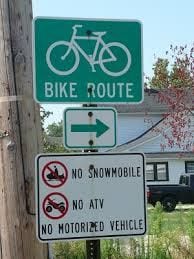
 Then give a prompt (connected to curricular goals) that provides an opportunity to decide when it would be helpful to use a macro or close-up and when a wider shot might be a better choice. For example, you might build on lessons about butterfly habitat:
Then give a prompt (connected to curricular goals) that provides an opportunity to decide when it would be helpful to use a macro or close-up and when a wider shot might be a better choice. For example, you might build on lessons about butterfly habitat: And if you’re skeptical about young children’s abilities to impact their communities, take a lesson from second graders at Caroline Elementary School. As part of a science curriculum that integrates media literacy, they made a
And if you’re skeptical about young children’s abilities to impact their communities, take a lesson from second graders at Caroline Elementary School. As part of a science curriculum that integrates media literacy, they made a  Everyone teaches the seasons. How about helping children analyze common depictions of seasons (e.g., posters at schools, holiday cards, store signs and decorations) and compare those media to their actual lives?
Everyone teaches the seasons. How about helping children analyze common depictions of seasons (e.g., posters at schools, holiday cards, store signs and decorations) and compare those media to their actual lives? To help children compare the poster’s messages about seasons to what really happens where they live, have them take a picture of the same thing(s) outdoors over the course of a school year and note the changes over time. Ask children to determine what they should photograph. What in their environment changes and what stays the same? You might want to invite them to photograph different types of plants to see which change a lot and which seem not to change at all. That might spark an investigation of the difference between, say, deciduous trees and evergreens. This could be especially effective if your poster of the seasons uses a changing tree to symbolize the four seasons.
To help children compare the poster’s messages about seasons to what really happens where they live, have them take a picture of the same thing(s) outdoors over the course of a school year and note the changes over time. Ask children to determine what they should photograph. What in their environment changes and what stays the same? You might want to invite them to photograph different types of plants to see which change a lot and which seem not to change at all. That might spark an investigation of the difference between, say, deciduous trees and evergreens. This could be especially effective if your poster of the seasons uses a changing tree to symbolize the four seasons. When weather precludes time outdoors, turn attention to analyzing media messages about nature, ecology, or sustainability. Help children use media literacy questions to examine their books, apps, movies, or games. Focusing on media they already know works best. Model asking questions like:
When weather precludes time outdoors, turn attention to analyzing media messages about nature, ecology, or sustainability. Help children use media literacy questions to examine their books, apps, movies, or games. Focusing on media they already know works best. Model asking questions like: You might also help children look at food packaging. Identify food packaging as a form of advertising, which is a form of communication. What’s the package saying to us? Are there clues that children can spot that tell them which packages contain foods that are from plants, trees, vines, or bushes? Which just pretend that real fruit or vegetables are inside? Hint: Teach children to look for the word “flavored.” Even if the word is different in their home language, the packages they are likely to encounter in the U.S. will use the English word, so teach the word in both languages. Pre-readers can look for the first couple of letters, “F” and “L.” When the word “flavored” is accompanied by pictures of real fruit or vegetables it means that the package is almost certainly wearing a disguise. Real foods don’t need fancy or disguised packages to tempt us – they’re delicious all by themselves!
You might also help children look at food packaging. Identify food packaging as a form of advertising, which is a form of communication. What’s the package saying to us? Are there clues that children can spot that tell them which packages contain foods that are from plants, trees, vines, or bushes? Which just pretend that real fruit or vegetables are inside? Hint: Teach children to look for the word “flavored.” Even if the word is different in their home language, the packages they are likely to encounter in the U.S. will use the English word, so teach the word in both languages. Pre-readers can look for the first couple of letters, “F” and “L.” When the word “flavored” is accompanied by pictures of real fruit or vegetables it means that the package is almost certainly wearing a disguise. Real foods don’t need fancy or disguised packages to tempt us – they’re delicious all by themselves!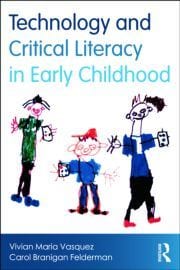 BTW, If you want a great example of how kindergartners compared websites to learn how best to grow tomato plants, check out Vivian Vasquez’s & Carol Felderman’s brilliant book,
BTW, If you want a great example of how kindergartners compared websites to learn how best to grow tomato plants, check out Vivian Vasquez’s & Carol Felderman’s brilliant book, 



